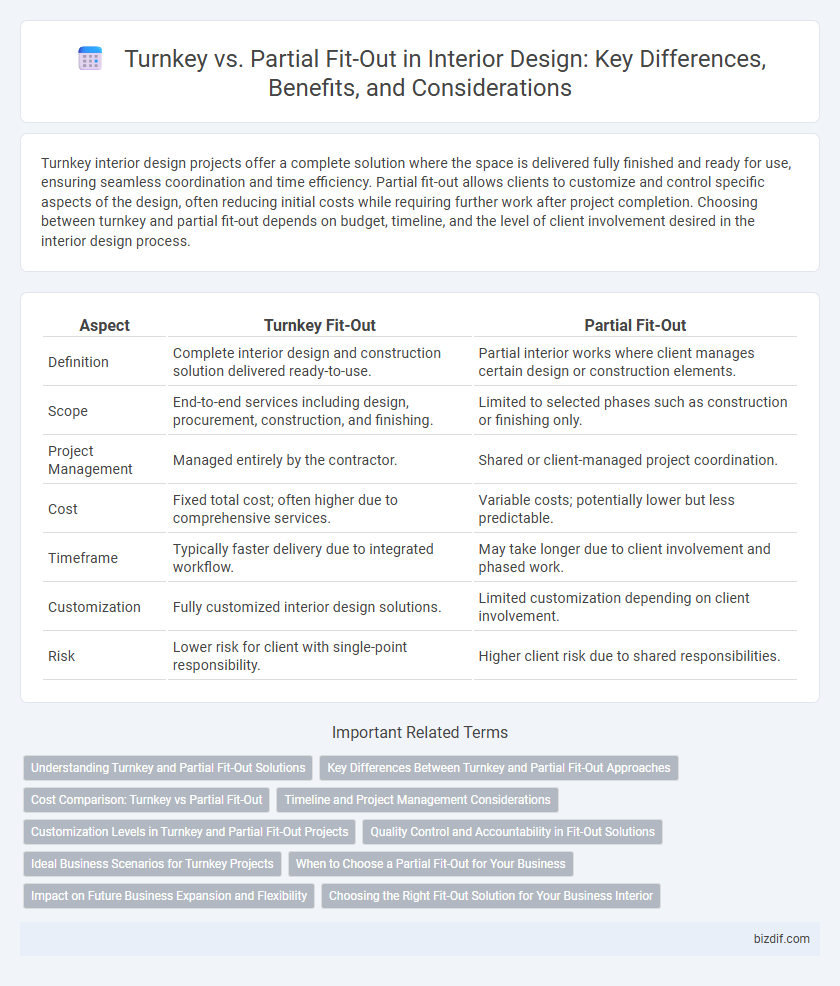Turnkey interior design projects offer a complete solution where the space is delivered fully finished and ready for use, ensuring seamless coordination and time efficiency. Partial fit-out allows clients to customize and control specific aspects of the design, often reducing initial costs while requiring further work after project completion. Choosing between turnkey and partial fit-out depends on budget, timeline, and the level of client involvement desired in the interior design process.
Table of Comparison
| Aspect | Turnkey Fit-Out | Partial Fit-Out |
|---|---|---|
| Definition | Complete interior design and construction solution delivered ready-to-use. | Partial interior works where client manages certain design or construction elements. |
| Scope | End-to-end services including design, procurement, construction, and finishing. | Limited to selected phases such as construction or finishing only. |
| Project Management | Managed entirely by the contractor. | Shared or client-managed project coordination. |
| Cost | Fixed total cost; often higher due to comprehensive services. | Variable costs; potentially lower but less predictable. |
| Timeframe | Typically faster delivery due to integrated workflow. | May take longer due to client involvement and phased work. |
| Customization | Fully customized interior design solutions. | Limited customization depending on client involvement. |
| Risk | Lower risk for client with single-point responsibility. | Higher client risk due to shared responsibilities. |
Understanding Turnkey and Partial Fit-Out Solutions
Turnkey interior design solutions deliver a fully completed space ready for immediate use, encompassing design, construction, and furnishing managed by a single contractor, ideal for clients seeking a hassle-free experience. Partial fit-out services focus on specific elements like partitioning, flooring, or ceilings, allowing clients to customize or manage remaining build-outs independently, offering flexibility and cost control. Selecting between turnkey and partial fit-out depends on project scope, budget, timeline, and desired involvement in the design and construction process.
Key Differences Between Turnkey and Partial Fit-Out Approaches
Turnkey interior design projects deliver a fully completed space, including design, construction, and furnishing, enabling clients to move in immediately upon completion. Partial fit-out focuses on core elements such as finishing floors, ceilings, and walls, leaving specialized tasks like furniture installation and equipment setup to be completed later. The turnkey approach offers convenience and time efficiency, while partial fit-out provides flexibility and potential cost savings by allowing phased customization.
Cost Comparison: Turnkey vs Partial Fit-Out
Turnkey interior design projects typically involve higher upfront costs due to comprehensive services covering design, materials, and installation, whereas partial fit-outs offer more budget flexibility by focusing on specific areas or components. Cost savings in partial fit-outs arise from selective upgrades and phased implementations, minimizing disruption and cash flow impact. Businesses opting for turnkey solutions benefit from cost predictability and streamlined project management, often justifying the premium with overall time and resource efficiency.
Timeline and Project Management Considerations
Turnkey interior design projects offer a streamlined timeline by consolidating design, procurement, and construction into a single contract, reducing delays and simplifying project management. Partial fit-out projects require more coordination between multiple contractors and clients, often extending the timeline due to sequential phases and separate management responsibilities. Effective communication and detailed scheduling are critical in managing partial fit-outs to avoid misalignment and ensure timely completion.
Customization Levels in Turnkey and Partial Fit-Out Projects
Turnkey projects in interior design offer high customization levels, allowing clients to tailor every aspect from layout to finishes according to their specific needs. Partial fit-out projects provide moderate customization, focusing primarily on essential elements such as partitioning and basic electrical work while leaving other design decisions to the client. This differentiation in customization impacts project timelines and budget flexibility, influencing client choice based on their desired involvement and design control.
Quality Control and Accountability in Fit-Out Solutions
Turnkey fit-out solutions provide comprehensive quality control by managing the entire interior design process under one contract, ensuring consistent standards and minimizing risks of defects. Partial fit-out options offer more flexibility but require clients to coordinate multiple contractors, which can complicate accountability and increase the potential for discrepancies in material quality and workmanship. Effective quality control in either approach depends on rigorous project management, clear contractual obligations, and regular site inspections to uphold design specifications and regulatory compliance.
Ideal Business Scenarios for Turnkey Projects
Turnkey projects are ideal for businesses seeking streamlined interior design solutions with a single point of responsibility, reducing complexities in coordination and project management. Companies launching new offices or retail spaces benefit from turnkey arrangements due to faster turnaround times and comprehensive service delivery, from design conception to final installation. This approach suits organizations prioritizing efficiency, cost control, and a cohesive design outcome without the need for multiple contractors.
When to Choose a Partial Fit-Out for Your Business
Choosing a partial fit-out is ideal for businesses seeking customized interior solutions while maintaining control over key elements such as design and materials. This option suits companies that want to manage budget allocation carefully and prefer to engage specialized contractors for specific fit-out components. Partial fit-outs offer flexibility to adapt spaces gradually, aligning renovations with evolving business needs and operational timelines.
Impact on Future Business Expansion and Flexibility
Turnkey fit-out offers a fully completed space ready for immediate use, which can limit customization and adaptability for future business expansion. Partial fit-out allows businesses to control the design process, providing greater flexibility to modify or expand the space as operational needs evolve. Choosing partial fit-out supports scalable growth and adaptable layouts, essential for dynamic business environments.
Choosing the Right Fit-Out Solution for Your Business Interior
Turnkey fit-out solutions offer comprehensive services from design to completion, ideal for businesses seeking a hassle-free, ready-to-use interior. Partial fit-outs provide flexibility by allowing companies to customize specific areas, optimizing budget and functionality based on immediate operational needs. Selecting the right fit-out depends on project scope, timeline, and desired control over design elements to align with business objectives and brand identity.
Turnkey vs Partial Fit-Out Infographic

 bizdif.com
bizdif.com